The translucent concrete market, valued at USD 16.8 million in 2025 and projected to reach USD 469.7 million by 2035, with a remarkable CAGR of 39.5%, exhibits a market maturity curve indicative of an early-stage innovation adoption pattern. Initial market penetration is constrained by high production costs, specialized manufacturing requirements, and limited awareness among construction stakeholders, resulting in slow adoption during the first two forecast years.
The market demonstrates an initial innovator phase from 2025 to 2026, characterized by adoption among niche architectural and premium construction projects where aesthetic and functional benefits justify premium pricing. From 2027 onwards, the market enters the early adopter phase, where increased project experimentation, pilot installations, and demonstration projects contribute to accelerated adoption. This period sees compound annual growth increasing sharply, reflecting the growing recognition of translucent concrete for façade applications, interior partitions, and urban design features. By the mid-2030s, the market is projected to approach the early majority stage, where improved manufacturing efficiencies, cost reductions, and standardized installation protocols drive broader commercial acceptance.
The adoption lifecycle of the market exhibits a classic exponential growth trajectory, with initial slow uptake giving way to rapid scaling as technical barriers are diminished and cost-effectiveness improves. The market’s maturity curve suggests that by 2035, the technology will transition from a high-value niche solution to a more mainstream construction material, establishing long-term commercial viability across diverse building applications.
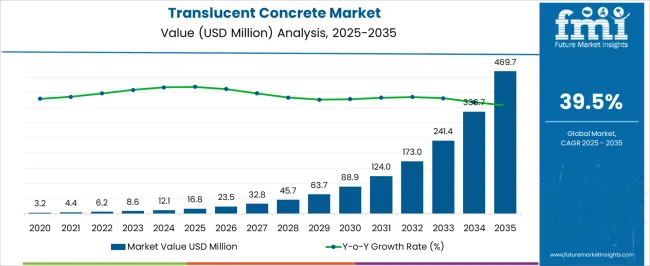
| Metric | Value |
|---|---|
| Translucent Concrete Market Estimated Value in (2025 E) | USD 16.8 million |
| Translucent Concrete Market Forecast Value in (2035 F) | USD 469.7 million |
| Forecast CAGR (2025 to 2035) | 39.5% |
The translucent concrete market represents a specialized segment within the global construction materials and architectural design industry, emphasizing aesthetics, natural lighting, and structural performance. Within the broader concrete and cement sector, it accounts for about 2.8%, driven by adoption in façades, interior walls, partitions, and decorative elements. In the advanced building materials and specialty concrete segment, its share is approximately 3.4%, reflecting integration of optical fibers, light-transmitting aggregates, and innovative casting techniques. Across the architectural and interior design market, it holds around 2.6%, supporting creative applications in commercial, residential, and public infrastructure projects.
Within the urban development and smart building materials category, it represents 2.2%, highlighting use in energy-efficient and visually appealing structures. In the overall construction innovation ecosystem, the market contributes about 1.9%, emphasizing performance, aesthetics, and functional design in modern buildings. Recent developments in the translucent concrete market have focused on material innovation, energy efficiency, and architectural flexibility. Groundbreaking trends include embedding optical fibers, resin-based light guides, and patterned light transmission systems to enhance natural illumination without compromising structural integrity. Key players are collaborating with architects, construction firms, and research institutions to create modular panels, façade systems, and interior partitions. Adoption of 3D casting techniques, advanced curing methods, and high-strength fiber composites is gaining traction for durable and scalable applications. The integration with smart lighting and energy-efficient building designs is emerging to enhance sustainability and operational efficiency.
The translucent concrete market is gaining traction as demand increases for sustainable and aesthetically appealing construction materials that blend architectural functionality with energy efficiency. The material’s unique ability to transmit light while maintaining structural integrity positions it as a desirable option for innovative building designs.
Rising emphasis on green construction and reduced reliance on artificial lighting is driving adoption, particularly in urban residential and commercial projects. Technological advancements have made production more scalable and cost-effective, broadening its accessibility across regions.
Governments and developers are increasingly incorporating translucent concrete into smart city frameworks and eco-friendly infrastructure. With growing architectural experimentation and demand for visually striking yet environmentally conscious materials, the market is expected to witness steady growth in the near term, driven by both new construction and renovation projects
The translucent concrete market is segmented by raw material, application, end-use, and geographic regions. By raw material, translucent concrete market is divided into Fiber and Concrete. In terms of application, translucent concrete market is classified into Roofing, Wall cladding, Flooring, and Others. Based on end-use, translucent concrete market is segmented into Residential and Non-Residential. Regionally, the translucent concrete industry is classified into North America, Latin America, Western Europe, Eastern Europe, Balkan & Baltic Countries, Russia & Belarus, Central Asia, East Asia, South Asia & Pacific, and the Middle East & Africa.
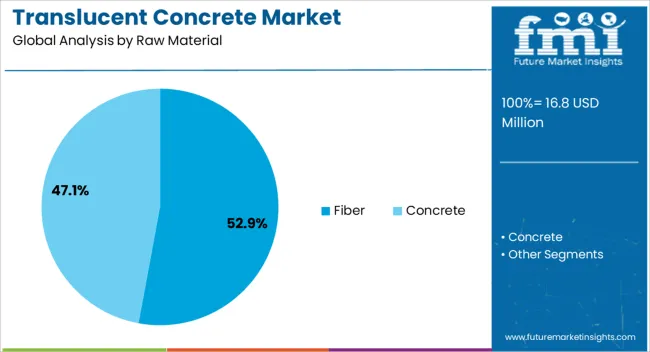
The fiber segment leads the raw material category with a commanding 52.9% market share, primarily due to its effectiveness in channeling light through concrete while maintaining strength and flexibility. Fiber materials, such as optical fibers and polymer-based strands, are widely used to transmit natural or artificial light through the concrete matrix, enabling visually dynamic lighting effects without compromising structural performance.
Their compatibility with precast methods and varying architectural formats makes fiber-based translucent concrete highly versatile. Demand is further supported by the shift toward innovative façade designs and interiors that emphasize light diffusion and thermal efficiency.
As building standards evolve to prioritize daylight usage and sustainability, fiber-integrated translucent concrete is expected to remain the preferred material choice among architects and engineers looking to balance form with function.
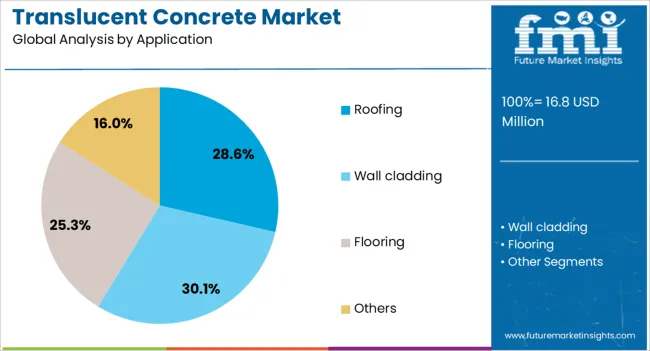
Roofing applications account for 28.6% of the translucent concrete market, driven by the material’s ability to enhance daylight penetration while ensuring weather resistance and insulation. Translucent concrete is increasingly used in roof panels to reduce reliance on artificial lighting and improve indoor environmental quality in both residential and commercial settings.
The segment benefits from architectural trends that prioritize open, naturally lit spaces and energy efficiency. Modern roofing systems incorporating translucent concrete offer aesthetic appeal, structural integrity, and functional advantages such as UV filtration and improved thermal comfort.
Adoption is further encouraged by green building certifications and growing interest in passive design principles. As construction firms seek materials that support energy goals and visual impact, the use of translucent concrete in roofing is anticipated to expand steadily.
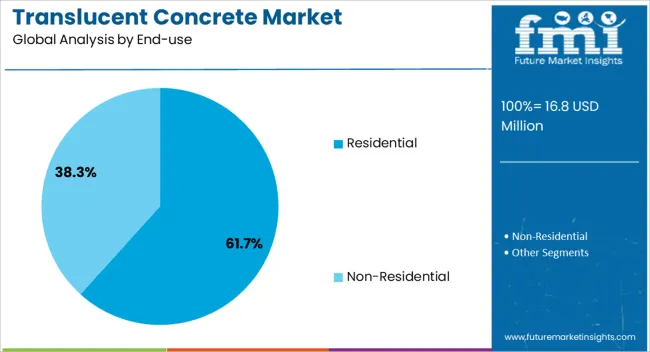
The residential sector holds the largest share at 61.7% in the end-use category, reflecting increasing consumer and developer interest in sustainable and visually appealing housing solutions. Translucent concrete is being adopted in residential construction for its ability to create naturally illuminated spaces while maintaining privacy and structural performance.
The material is used in facades, partitions, and roofing to bring ambient lighting indoors without external power sources, supporting energy efficiency goals. With growing awareness of environmental impact and energy consumption, homeowners are seeking building materials that offer long-term savings and modern design appeal.
The segment is further bolstered by the rise in luxury and smart housing projects that incorporate advanced materials for both performance and aesthetics. Continued demand for green construction and daylight-optimized homes is expected to reinforce the residential segment’s dominance in the market.
The market has gained traction due to increasing architectural and aesthetic applications in modern construction projects. Translucent concrete, also known as light-transmitting concrete, incorporates optical fibers or light-guiding elements that allow natural or artificial light to pass through while maintaining structural integrity. This material is increasingly used in facades, partitions, decorative walls, and flooring to enhance visual appeal and energy efficiency in buildings. Architects and designers are adopting translucent concrete for innovative lighting effects and sustainable design integration. Rising construction activities, growing interest in unique building aesthetics, and increasing demand for energy-efficient materials have fueled the development and adoption of translucent concrete globally, positioning it as a functional and decorative solution in contemporary architecture.
The adoption of translucent concrete has been primarily driven by its ability to combine structural strength with aesthetic versatility. Incorporation of optical fibers allows for the creation of dynamic light patterns, illuminated facades, and visually appealing interior partitions. Designers leverage the material to achieve modern, transparent effects without compromising building safety. The application of translucent concrete in hotels, commercial complexes, museums, and residential projects has expanded its demand. Beyond aesthetic enhancement, architects are using this material to create interactive designs and integrated lighting solutions that enhance user experiences. This dual functionality of translucency and structural capability has encouraged builders and developers to incorporate it in premium and innovative construction projects, boosting market adoption.
Translucent concrete contributes to energy efficiency by allowing natural light penetration into interior spaces, reducing dependency on artificial lighting during daytime. Buildings constructed with translucent concrete panels or facades can achieve enhanced illumination while maintaining insulation properties. The material is suitable for green building certifications and eco-conscious design projects. Its ability to combine daylighting with thermal performance supports sustainable construction practices. In addition to energy savings, translucent concrete reduces the need for excessive electrical installations and lighting fixtures, resulting in cost efficiencies during both construction and operation. Increasing awareness of environmentally responsible construction practices and regulatory encouragement for energy-efficient materials has strengthened market adoption across commercial and public infrastructure.
Advancements in manufacturing techniques, optical fiber integration, and concrete formulation have enhanced the performance and versatility of translucent concrete. Innovations include the development of high-strength panels, customizable fiber arrangements, and improved light diffusion patterns. These advancements have enabled wider adoption across both interior and exterior applications. In addition, prefabricated translucent concrete panels reduce installation time and labor requirements, improving construction efficiency. Research into combining translucent concrete with other functional materials such as self-cleaning coatings, fire resistance additives, and acoustic enhancements has expanded its market potential. Continuous R&D efforts and technological improvements are driving innovation, making translucent concrete increasingly feasible for large-scale, sustainable, and decorative building projects globally.
Europe and North America lead the market due to advanced construction techniques, strong architectural design demand, and higher aesthetic awareness. Asia Pacific is witnessing rapid growth, supported by urbanization, commercial construction expansion, and innovative architectural projects in cities. Market participants are focusing on strategic collaborations, customized product offerings, and investment in manufacturing facilities to strengthen regional presence. The competitive landscape is characterized by technological differentiation, premium product development, and partnerships with architectural and construction firms. Increasing awareness of sustainable and energy-efficient construction materials, along with growing investment in infrastructure projects, continues to drive adoption, positioning translucent concrete as a key solution in modern architectural design and construction globally.
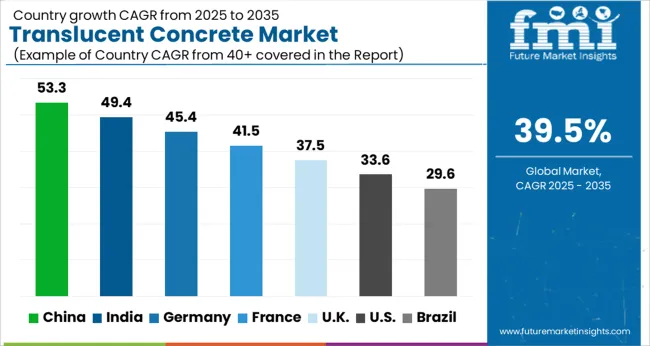
| Country | CAGR |
|---|---|
| China | 53.3% |
| India | 49.4% |
| Germany | 45.4% |
| France | 41.5% |
| UK | 37.5% |
| USA | 33.6% |
| Brazil | 29.6% |
The market is expected to expand at a remarkable CAGR of 39.5% from 2025 to 2035, driven by rising adoption in architectural, commercial, and urban infrastructure projects. Adoption is highest in China at 53.3%, reflecting significant investments in innovative building materials and high-rise developments. India follows with 49.4%, supported by growing infrastructure modernization and aesthetic construction trends. Germany records 45.4%, with advanced engineering capabilities facilitating integration into modern architectural designs. The UK stands at 37.5%, benefiting from pilot projects and sustainable construction initiatives, while the USA at 33.6% demonstrates adoption in commercial and public infrastructure. These markets highlight global momentum toward integrating functional and aesthetic concrete solutions. This report includes insights on 40+ countries; the top markets are shown here for reference.
China is witnessing a CAGR of 53.3%, driven by rapid adoption in architectural projects, commercial buildings, and urban infrastructure requiring aesthetic and functional design elements. The material’s ability to allow natural light transmission while maintaining structural integrity has increased its appeal in high-profile construction projects. Chinese construction firms collaborate with international suppliers to deploy innovative panel designs and optimized production techniques. Government-led urban redevelopment initiatives and increasing preference for visually striking façades further support market growth.
India is expanding at a CAGR of 49.4%, fueled by demand in high-end commercial projects, hotels, and smart city initiatives. Developers are incorporating translucent concrete for façades, partitions, and lighting-focused architectural elements. Collaboration between local and global technology providers enables adoption of prefabricated panels and custom lighting solutions. Market growth is enhanced by increasing awareness among architects and designers about energy-efficient daylighting solutions and aesthetic potential of translucent concrete.
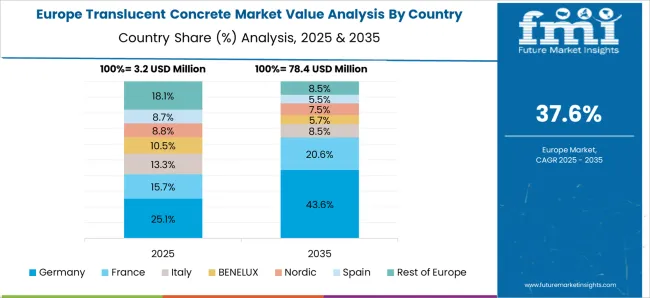
Germany is witnessing a CAGR of 45.4%, supported by innovation in construction materials, energy-efficient building design, and aesthetic modernization. The market emphasizes daylight transmission, energy efficiency, and design flexibility in office buildings, museums, and residential projects. German companies leverage advanced production processes and high-quality materials to maintain performance and structural reliability. EU regulations promoting sustainable and innovative construction solutions further stimulate adoption.
The United Kingdom is projected to grow at a CAGR of 37.5%, driven by architectural innovation, public infrastructure upgrades, and smart building projects. Translucent concrete is adopted for façades, interior partitions, and decorative applications to enhance daylight utilization. Partnerships between architects and technology providers enable customized panels and modular installation solutions. Increasing focus on design-driven urban development and energy efficiency supports market growth.
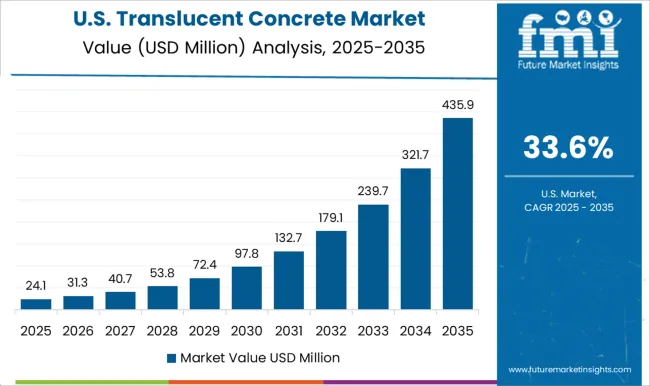
The United States is expanding at a CAGR of 33.6%, supported by adoption in commercial, institutional, and residential projects seeking innovative daylighting and design solutions. Construction firms leverage prefabricated panels and modular installation methods to reduce costs and accelerate project timelines. Focus on energy efficiency, modern aesthetics, and high-performance concrete supports adoption across urban centers. Collaborative developments between US manufacturers and international technology providers strengthen the market.
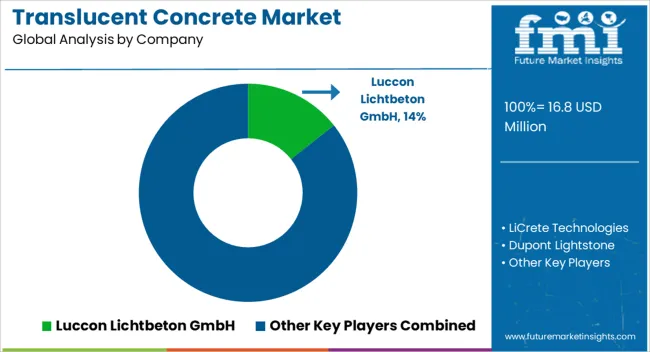
The market is characterized by specialized manufacturers focusing on architectural innovation and functional aesthetics. Luccon Lichtbeton GmbH is a leading player, offering high-quality light-transmitting concrete panels and blocks with consistent performance and customizable design, widely adopted in commercial and public infrastructure projects. Litracon Ltd and Litracon Bt. compete with advanced fiber-optic embedded concrete solutions, emphasizing energy efficiency, durability, and versatile applications for façades, interior walls, and decorative installations. LiCrete Technologies and Dupont Lightstone leverage proprietary technologies to enhance translucency and structural integrity, targeting high-end architectural projects and urban developments. Regional players such as Transparent Concrete Hub, Italcementi Group, and Buchs Beton provide locally optimized solutions with integrated design support, while smaller innovators like Lucem GmbH, LuceM UG, and Translucent Crete LLC focus on niche markets, offering modular and customizable light-transmitting panels suitable for artistic or landmark installations. The competitive landscape is defined by technological differentiation, product customization, and aesthetic versatility. Companies compete through investment in fiber-optic integration, polymer additives, and surface finish technologies, aiming to deliver both visual appeal and structural performance. Market success is increasingly influenced by partnerships with architects, construction firms, and urban planners, as well as compliance with sustainability and building safety standards.
| Item | Value |
|---|---|
| Quantitative Units | USD 16.8 Million |
| Raw Material | Fiber and Concrete |
| Application | Roofing, Wall cladding, Flooring, and Others |
| End-use | Residential and Non-Residential |
| Regions Covered | North America, Europe, Asia-Pacific, Latin America, Middle East & Africa |
| Country Covered | United States, Canada, Germany, France, United Kingdom, China, Japan, India, Brazil, South Africa |
| Key Companies Profiled | Luccon Lichtbeton GmbH, LiCrete Technologies, Dupont Lightstone, Litracon Ltd, Litracon Bt., Transparent Concrete Hub, Italcementi Group, Buchs Beton, LCT GesmbH, Translucent Crete LLC, Lucem GmbH, LuceM UG, LCTG, Luccon LLC, and Luccon UK Ltd. |
| Additional Attributes | Dollar sales by concrete type and application, demand dynamics across architectural, commercial, and public infrastructure projects, regional trends in innovative building material adoption, innovation in light-transmitting aggregates, durability, and structural performance, environmental impact of material production and lifecycle energy, and emerging use cases in façades, decorative panels, and energy-efficient lighting integration. |
The global translucent concrete market is estimated to be valued at USD 16.8 million in 2025.
The market size for the translucent concrete market is projected to reach USD 469.7 million by 2035.
The translucent concrete market is expected to grow at a 39.5% CAGR between 2025 and 2035.
The key product types in translucent concrete market are fiber and concrete.
In terms of application, roofing segment to command 28.6% share in the translucent concrete market in 2025.
Explore Similar Insights

Thank you!
You will receive an email from our Business Development Manager. Please be sure to check your SPAM/JUNK folder too.
Chat With
MaRIA